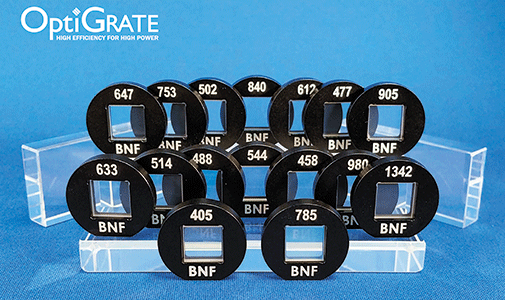OptiGrate Corp.
Company Description
OptiGrate Corp. designs and manufactures ultra-narrow band optical filters based on volume Bragg grating (VBG) technologies in proprietary photo-thermo-refractive glass. Filters with ultra-narrow bandwidth are formed by holographic techniques in the bulk of glass material, and demonstrate superior optical quality, outstanding durability, environmental stability, and high optical damage threshold. OptiGrate is a pioneer and world leader in VBG technologies. For over 15 years, OptiGrate has delivered holographic optical elements (HOE) to a large number of government contractors and OEMs in optoelectronics, analytical, medical, defense, and other industries. Since May 2017, OptiGrate is a part of the IPG Photonics Family.

Markets
OptiGrate supplied ultra-narrow band filters to hundreds of customers on five continents. These filters are used for: Raman spectroscopy and microscopy; semiconductor, solid state, and fiber lasers; hyperspectral and Raman imaging systems; ultrafast laser systems; optical recording and storage; medical diagnostics and treatment; and more.
Main Product Lines
- Ultra-narrow band optical notch and bandpass filters with linewidth less than 10 cm-1
- Laser resonator mode selection filters/mirrors for spectral narrowing and thermal stabilization of lasers
- Deflectors - transmitting volume Bragg gratings for angular filtering and deflection of laser light
- Chirped volume Bragg gratings for compact and robust stretchers and compressors of ultra-short laser pulses
- Spectral beam combiner - angular and spectral filters for high-power laser spectral beam combining
Facilities
OptiGrate moved to a new location in Oviedo, Florida, to accommodate an increased demand for the firm's volume Bragg grating (VBG) products and allow for future expansion. The new 10,000 sq. ft., state-of-the-art facility was specially designed and engineered for production of VBG filters. The facility-the only vertically integrated VBG production plant in the world-includes a photo-thermo-refractive glass production unit, a VBG holographic production unit, and a VBG laser application development lab.

OptiGrate Corp.
562 South Econ Circle
Oviedo, FL 32765
TELEPHONE
(407) 542-7704
FAX
(407) 542-7804
E-MAILinfo@optigrate.com
WEB SITEwww.optigrate.com
NUMBER OF EMPLOYEES
40
YEAR FOUNDED
1999

New Multi-Spectroscopic System Enhances Cultural Heritage Analysis
April 2nd 2025A new study published in Talanta introduces SYSPECTRAL, a portable multi-spectroscopic system that can conduct non-invasive, in situ chemical analysis of cultural heritage materials by integrating LIBS, LIF, Raman, and reflectance spectroscopy into a single compact device.
Thermo Fisher Scientists Highlight the Latest Advances in Process Monitoring with Raman Spectroscopy
April 1st 2025In this exclusive Spectroscopy interview, John Richmond and Tom Dearing of Thermo Fisher Scientific discuss the company’s Raman technology and the latest trends for process monitoring across various applications.